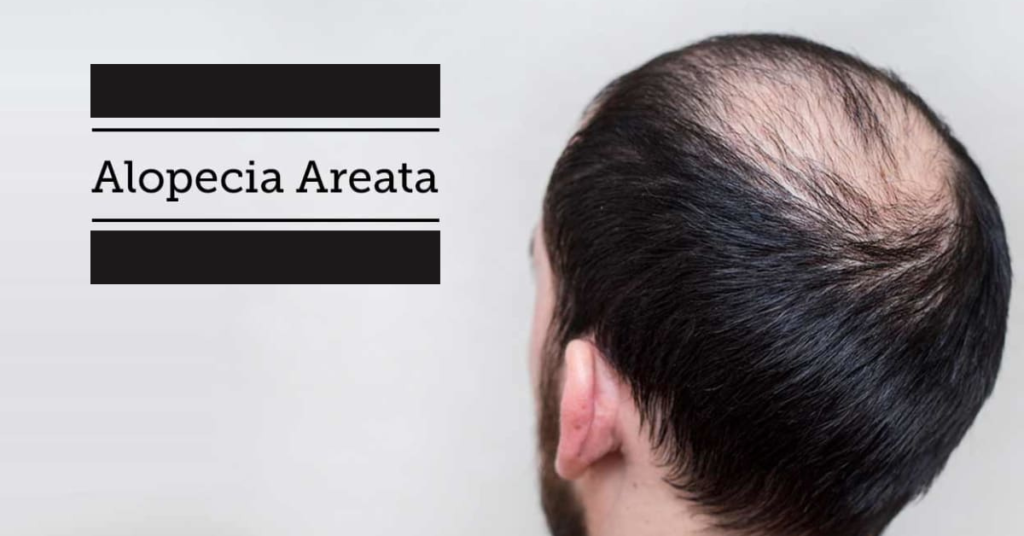What is alopecia areata?
Alopecia areata is a type of localized hair loss that is typically seen as bald patches. It may affect any hairy area of the body. In the majority of cases, hair regrows after several months.
Causes of alopecia areata
Alopecia areata is considered to be an autoimmune disease. This occurs when the body’s own immune system damages its healthy cells.
In Alopecia areata, white blood cells gather around the affected hair roots (hair follicles). This causes inflammation which leads to hair loss.
Genetics, atopy and environmental factors play a role.
It is not a hereditary condition
Clinical features
It typically occurs as one or more bald patches on the scalp. It can affect any hairy area of the body.
Hair loss may be seen on the scalp, beard, mustache, eyebrows, eyelashes or body hair may also be lost. Scalp is the common site affected in 90% of the cases. Apart from the bald patches, the scalp usually looks healthy and there is no scarring.
The bald patches are round in shape and about the size of a coin.
The nails may be affected in about 1 in 10 cases of Alopecia areata
What are the treatment options in Alopecia areata?
Steroid injections Injections of steroids (Triamcinolone acetonide) into the bald patches of the scalp suppress the local immune reaction that occurs in Alopecia areata and allow the regrowth. This treatment may be an option for one or more small- to medium-sized bald patches. Injections are repeated every 4-6 weeks. It takes 1-2 months for the hair to start to regrow. There is no guarantee that any hair re-grown during treatment will persist. Topical steroids and immunomodulators Steroid cream, gel, etc, can be used but these are not as effective as steroid injections. Topical steroids are to be strictly used under medical supervision and prolonged use should be avoided. Topical corticosteroid-sparing agents such as tacrolimus can be used in sites such as eyebrows. Topical minoxidil solution Applied to the bald patches and has been shown to promote hair re-growth in some cases. Contact immunotherapy Topical immunotherapy is the most effective option for people with substances like diphenylcyclopropenone (DPCP) is applied on the affected skin to make the skin react like an allergy or dermatitis (eczema). The skin reaction affect the process involved in causing Alopecia areata to regrow hair
Various other treatments include the following: Other treatments 8. Can Alopecia patches progress from one bald patch to extensive involvement? Alopecia areata is a cosmetic problem. The change in appearance may cause anxiety, depression or feelings of unattractiveness. In children with Alopecia areata, change in child’s behavior may be noted and the child may have low self-esteem and appear withdrawn. 10. What can be done to overcome the psychological distress associated with Alopecia areata? Phototherapy has been used with limited success with either psoralen combined with ultraviolet A (PUVA) or narrow-band UVB therapy. Systemic steroids are used for rapidly progressive and extensive involvement as long-term or short-term treatment.
Immunosuppressive drugs such as cyclosporine, azathioprine, or methotrexate may be used.
Wigs are considered in resistant cases.
Tattooing can be considered in case of eyebrow hair loss for cosmetic reasons.
The bald patches start in childhood. If there is a history of atopic eczema(A type of skin allergy). If there is a family history of Alopecia areata. The initial bout of hair loss affects more than half of the scalp area. When eyelashes and/or eyebrows are involved. Hair loss is around the scalp margin. Nail changes are present. Underlying autoimmune diseases like vitiligo, lichen planus, thyroid disorders or diabetes mellitus may be present Learn to develop positive feedback mechanisms and accept the change in appearance. Consult a dermatologist for appropriate counseling and treatment. A consult with a clinical or pediatric psychologist may be needed in


